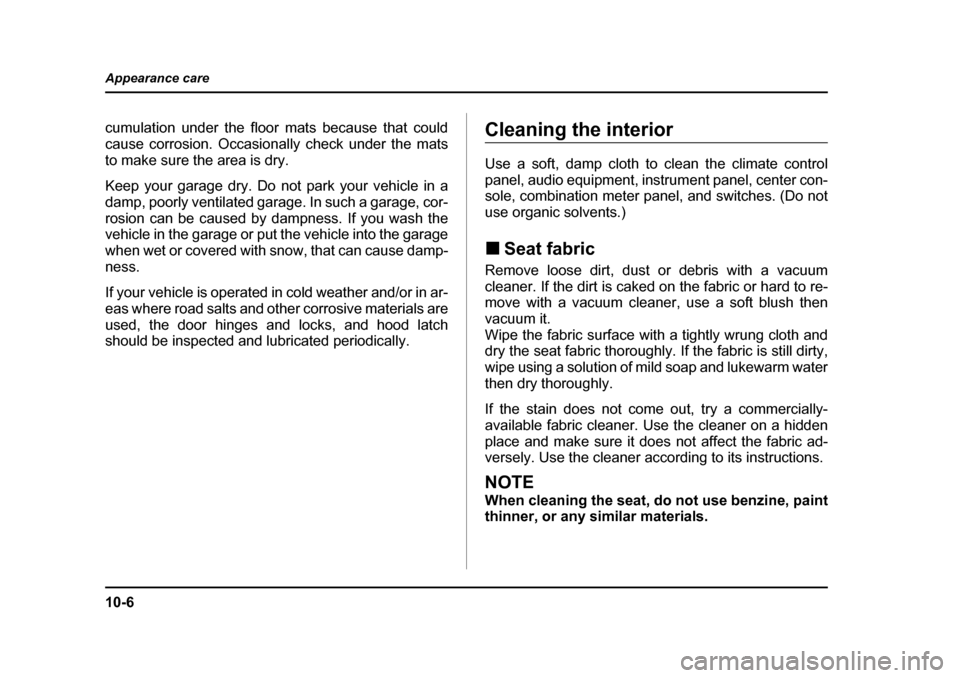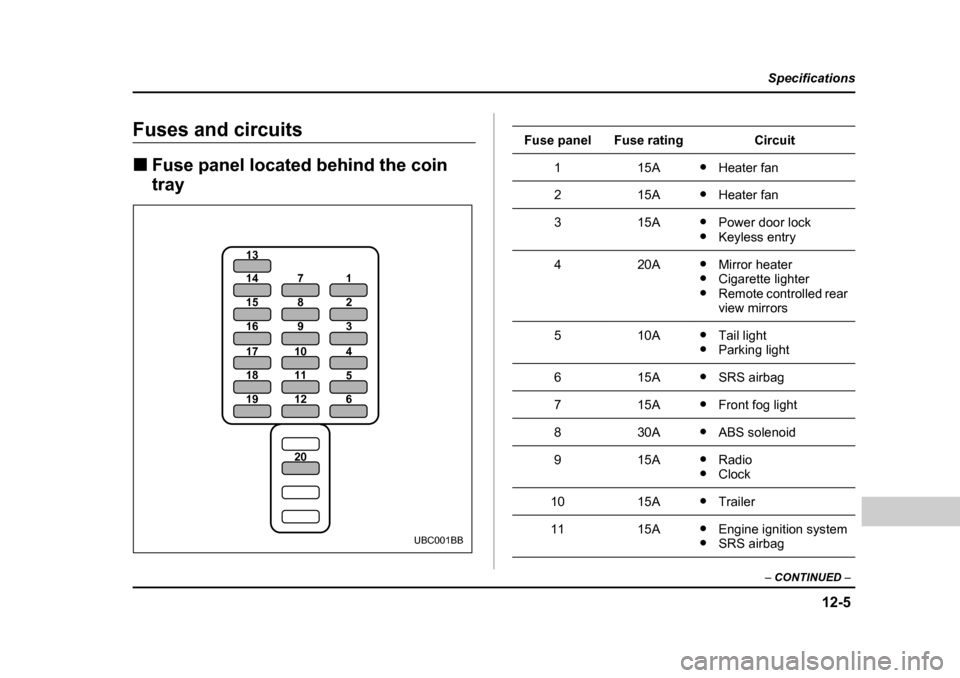2006 SUBARU BAJA door lock
[x] Cancel search: door lockPage 313 of 487

8-20
Driving tips
door shows GVWR (Gross Vehicle Weight Rating)
and GAWR (Gross Axle Weight Rating).
The GVW (Gross Vehicle Weight) must never exceed
the GVWR. GVW is the combined total of weight of the
vehicle, fuel, driver, all
passengers, luggage, any op-
tional equipment and trailer tongue load. Therefore,
the GVW changes depending on the situation.
In addition, the total weight applied to each axle
(GAW) must never exceed the GAWR. The front and
rear GAWs can be adjusted by relocating luggage in- side the vehicle.
Even if the total weight of your luggage is lower than
the vehicle capacity weight, either front or rear GAW
may exceed the GAWR, depending on the distribution
of the luggage.
When possible, the load should be evenly distributed
throughout the vehicle.
If you carry heavy loads in the vehicle, you should con-
firm that GVW and front and rear GAWs are within the
GVWR and GAWR by putting your vehicle on a vehi-
cle scale, found at a commercial weighing station.
Do not use replacement tires with a lower load range
than the originals because they may lower the GVWR
and GAWR limitations. Replacement tires with a high-
er load range than the originals do not increase the
GVWR and GAWR limitations.Trailer hitch (if equipped)
�y Never exceed the maximum weight specified
for the trailer hitch. Exceeding the maximum
weight could cause an accident resulting in se-
rious personal injuries. Permissible trailer
weight changes depending on the situation. Re-
fer to the next section “Trailer towing” for pos-
sible recommendations and limitations. �y Trailer brakes are required when the towing
load exceeds 1,000 lbs (453 kg). Be sure your
trailer has safety chains and that each chain
will hold the trailer’s maximum gross weight.
Towing trailers without safety chains could cre-
ate a traffic safety hazard if the trailer separates
from the hitch due to coupling damage or hitch
ball damage. �y Be sure to check the hitch pin and safety pin
for positive locking placement before towing a
trailer. If the ball moun t comes off the hitch re-
ceiver, the trailer could get loose and create a
traffic safety hazard.�y Use only the ball mount supplied with this
hitch. Use the hitch only as a weight carrying
hitch. Do not use with any type of weight dis-
Page 363 of 487

10-6
Appearance care
cumulation under the floor mats because that could
cause corrosion. Occasionally check under the mats
to make sure the area is dry.
Keep your garage dry. Do
not park your vehicle in a
damp, poorly ventilated garage. In such a garage, cor-
rosion can be caused by dampness. If you wash the
vehicle in the garage or put the vehicle into the garage
when wet or covered with snow, that can cause damp-
ness.
If your vehicle is operated in cold weather and/or in ar-
eas where road salts and other corrosive materials are
used, the door hinges a nd locks, and hood latch
should be inspected and lubricated periodically.Cleaning the interior
Use a soft, damp cloth to clean the climate control
panel, audio equipment, instrument panel, center con-
sole, combination meter panel, and switches. (Do not
use organic solvents.) �„ Seat fabric
Remove loose dirt, dust or debris with a vacuum
cleaner. If the dirt is caked on the fabric or hard to re-
move with a vacuum cleaner, use a soft blush then
vacuum it.
Wipe the fabric surface with a tightly wrung cloth and
dry the seat fabric thoroughly. If the fabric is still dirty,
wipe using a solution of mild soap and lukewarm water
then dry thoroughly.
If the stain does not come out, try a commercially-
available fabric cleaner. Use the cleaner on a hidden
place and make sure it does not affect the fabric ad-
versely. Use the cleaner according to its instructions.
NOTE
When cleaning the seat, do not use benzine, paint
thinner, or any similar materials.
Page 452 of 487

12-5
Specifications
– CONTINUED –
Fuses and circuits �„Fuse panel located behind the coin tray
19
18
17
16
20
15
14
12
11
10 9
8
7
6
5
4
3
2
1
13
UBC001BB
Fuse panelFuse ratingCircuit
115A�y
Heater fan
215A�yHeater fan
315A�yPower door lock
�y Keyless entry
420A�yMirror heater
�y Cigarette lighter
�y Remote controlled rear
view mirrors
510A�yTail light
�y Parking light
615A�ySRS airbag
715A�yFront fog light
830A�yABS solenoid
915A�yRadio
�y Clock
1015A�yTrailer
1115A�yEngine ignition system
�y SRS airbag
Page 479 of 487

14-4
Index
Differential gear oil
Front ........................................................... 11-32
Rear ............................................................ 11-33
Dimensions ........................................................ 12-2
Disarming the system ............................... 2-21, 2-23
Disc brake pad wear warning indicators ............ 7-32
Dome light ................................................ 6-2, 11-78
Door ajar warning lights ..................................... 3-15
Door locks ........................................................... 2-3
Drive belts ....................................................... 11-26
Driving
Car phone/cell phone ........................................ 8
Drinking ............................................................. 7
Drugs ................................................................. 7
Foreign countries ............. ............................... 8-6
Pets ................................................................... 8
Snowy and icy roads .................................... 8-13
Tips ..................................... 7-14, 7-19, 7-29, 8-7
Tired or sleepy ................................................... 8
E
Electrical system . ........................................... ... 12-3
Emergency Locking Retractor (ELR) ................. 1-16
Engine
Compartment overview ................................. 11-8
Coolant ....................................................... 11-18
Exhaust gas (Carbon monoxide) .................... 8-3 Hood ............................................................. 11-5
Oil ............................................................... 11-10
Overheating .................................................. 9-21
Starting ........................................................... 7-9
Stopping ....................................................... 7-11
Exterior care ..................... ................................. 10-2
F
Flat tires ............................................................ 9-12
Floor mat ........................................................... 6-15
Fluid level Automatic transmission ..... ......................... 11-29
Brake .......................................................... 11-38
Clutch ......................................................... 11-40
Power steering ........................................... 11-36
Folding down the rear seat ................................ 1-10
Front Differential gear oil ..................................... 11-32
Fog light ...................................................... 11-70
Fog light button ............................................. 3-24
Seatbelt pretensioners ................................. 1-24
Seats .............................................................. 1-2
Turn signal light, parking light and side
marker light .............................................. 11-71
Fuel ..................................................................... 7-2 Economy hints ................................................ 8-2
Filler door and cap .......................................... 7-4
Page 481 of 487

14-6
Index
LSD (Limited slip differential) ............................ 7-30 M
Main fuse ......................................................... 11-61
Maintenance
Precautions .................................................. 11-3
Schedule .............. ........................................ 11-3
Seatbelt ........................................................ 1-21
Malfunction indicator lamp (Check Engine
light) ............................................................... 3-12
Manual transmission ......................................... 7-12
Manual transmission oil ................................... 11-27
Map light .............................................................. 6-3
Maximum load limits .......................................... 8-25
Meters and gauges ............................................. 3-6
Mirrors ............................................................... 3-30
Moonroof ........................................................... 2-36 N
New vehicle break-in driving – the first 1,000
miles (1,600 km) .............................................. 8-2
O
Odometer/Trip meter ........................................... 3-6
Off road driving .................................................... 8-9 Oil level
Engine ........................................................ 11-10
Front differential (AT vehi cles) ................... 11-32
Manual transmission .................................. 11-27
Rear differential .............. ............................ 11-33
Oil pressure warning light .................................. 3-13
Outside mirrors .................... .............................. 3-32
Overheating engine ........................................... 9-21 P
Parking Brake ............................................................ 7-35
Brake stroke ............................................... 11-46
Light switch ................................................... 3-23
Periodic inspections ............................................ 8-6Power
Door locking switches ..................................... 2-5
Steering ........................................................ 7-31
Steering fluid .............................................. 11-36
Windows ....................................................... 2-25
R
Rear Center console ............................................... 6-6
Combination lights ...................................... 11-72
Differential gear oil ..................................... 11-33
Seats .............................................................. 1-9
Page 484 of 487

14-9
Index
V
Valet mode ........................................................ 2-21
Vanity mirror ........................................................ 6-4Vehicle
Capacity weight ............................................ 8-19
Identification ................................................. 12-9
Ventilator ............................................................. 4-2 W
Warning and indicator lights .............................. 3-11
Warning lights ABS ............ .................................................. 3-14
All-Wheel Drive ............................................. 3-16
Anti-lock Brake System ................................. 3-14
AT OIL TEMPerature .................................... 3-13
Brake system ....... ......................................... 3-15
Charge .......................................................... 3-13
CHECK ENGINE .......................................... 3-12
Door ajar ....................................................... 3-15
Oil pressure .................................................. 3-13
Seatbelt ............................................... 1-17, 3-11
SRS airbag system ... .................................... 3-11
Warranties and maintenance ............................ 8-25
Washing ............................................................ 10-2
Waxing and polishing ............. ........................... 10-3
Wear indicators ................ ............................... 11-50
Wheel Alignment ...................................................... 12-4
Balance ....................................................... 11-50
Replacement .............................................. 11-52
Windows ................. ........................................... 2-25
Windshield
Washer fluid ................................................ 11-53
Wiper and washer switches .......................... 3-26
Wiper deicer ................................................. 3-29
Winter driving .................................................... 8-11
Wiper and washer ................ ............................. 3-25